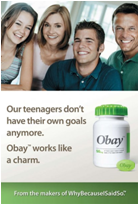 Ads like the one above have been appearing in public transit systems in Ottawa, Toronto and other Ontario cities over the last month, supposedly promoting a drug called “Obay” which prevents teenagers from having their own thoughts, hopes and dreams. It's a classic example of viral marketing: an ad campaign that doesn't actually name the product or service being promoted, but rather tries to get people talking about it in the hopes that when the product is finally unveiled the effect will be greater than a traditional ad campaign could have managed.
Ads like the one above have been appearing in public transit systems in Ottawa, Toronto and other Ontario cities over the last month, supposedly promoting a drug called “Obay” which prevents teenagers from having their own thoughts, hopes and dreams. It's a classic example of viral marketing: an ad campaign that doesn't actually name the product or service being promoted, but rather tries to get people talking about it in the hopes that when the product is finally unveiled the effect will be greater than a traditional ad campaign could have managed.
This “Obay” ad (one of several variations, in English and French) has certainly succeeded in getting people talking about it: organizations that have been suggested as the sponsors include Adbusters, the Web site Overstock.com, the United Church and the Church of Scientology. It even attracted enough attention for the Museum of Hoaxes to devote a page to it, for the benefit of those people who may have thought it was a real ad campaign.
Does viral marketing work? The most recent high-profile example, the movie “Cloverfield,” seems to suggest that it does. “Cloverfield” was promoted in part by mysterious trailers run before big-ticket movies like “Transformers,” and in part by fake Web sites like Slusho that provided hints about the movie's content. The result was nearly six months of blog buzz and record ticket sales for the weekend in which it was released.
“Cloverfield,” though, may be the exception rather than the rule. “Snakes On A Plane,” the last movie to receive a similar treatment, was a box-office disappointment, and “Wig Out,” the YouTube clip that drew nearly three million views, in the end brought little business to its sponsor Sunsilk. Even the success of “Cloverfield” shows the limits of viral marketing: its total box office after more than a month in theatres is $80 million dollars – not bad until you realize that fully half of that was earned in its first weekend. The viral campaign, it would seem, did not actually increase the movie's audience: it just got it into the theatre sooner.
One of the most common misconceptions about viral ads is that their success is accidental – that bloggers and YouTube users just happen to seize upon a clip like “Wig Out.” In fact, in order to be successful a viral marketing campaign requires at least as much planning as the traditional approach. YouTube, for instance, selects the thumbnail image for a clip from one of three frames in the exact middle of the clip; Dan Ackerman Greenberg, co-founder of viral marketing company the Comotion Group, suggests that advertisers ensure the middle of their clip has an arresting image such as a semi-naked woman. Similarly, Greenberg explains that it's not just by chance that bloggers promote clips and other viral marketing tools: “We reach out to individuals who run relevant blogs and actually pay them to post our embedded videos.”
As for “Obay,” it was eventually revealed to be an ad for… Colleges Ontario, a group which represents a number of colleges of applied arts and technology. It's unclear yet whether the campaign will be seen to be a success, but the fact that nobody seems to have guessed its actual meaning doesn't suggest that it will. Amusing though it is, the “Obay” campaign may be destined to be remembered as advertising that was too clever for its own good.
For Classroom Discussion
What do you think might be the advantages and disadvantages of viral marketing? Are there products or services for which it might be more or less useful? Why?
Do you think the “Obay” campaign is likely to be a successful one? Why or why not?
Why do you think Colleges Ontario might have chosen to use a viral approach for this campaign?
Do you think that it is appropriate to have advertising that hides its true nature? Should advertising have to identify what it is? Why or why not?
